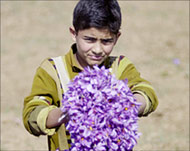Saffron industry withering in Kashmir
With saffron from Iran making its way into Indian markets, producers of the world’s most precious spice in Indian-administered Kashmir are worried about their future.

The Himalayan territory’s saffron is famed as the world’s finest, but even local consumers are turning to Iranian imports as Kashmiri produce sinks in quantity – and hence rises in price – due to a decade and a half of war.
“Saffron from Iran is not only being sold in major Indian cities, but also in Kashmir,” Ghulam Muhammad Bhat, the president of Kashmir’s saffron growers association said.
Best produce
Saffron, the dried orange stigmas of the purple crocus flower, is used in pinches in South Asian, Iranian and Arab cuisine, particularly rice and sweets. Its name comes from the Arabic word “Safra” meaning yellow.
Iranian saffron sells in India for 25,000 rupees ($550 dollars) a kilogramme, compared with 40,000 rupees ($885) a kilogramme for Kashmiri saffron.
“Let me assure you that ours is the best stuff,” Bhat boasted, pointing to a signpost reading, “World’s best saffron grows here.”
The saffron fields are 16km south of the summer capital Srinagar.
“This signpost has not been put here by the government for fun. Our saffron is rich in flavour, taste and colour,” he said, as hundreds of men, women and children bent to pluck fresh crocus.
Irrigation critical
Bhat said Iran had less land under cultivation for saffron than
Kashmir, but the yield there was four times as high because of irrigation.
“In Kashmir, we are totally dependent on rainwater.”
 |
|
Saffron is the dried stigma of the |
Saffron is a major employer in Kashmir and is cultivated in 226 villages. But production that was 40,000kg a year in the early 1990s has slumped to 8000kg annually.
Bhat said production could touch between 13,000 and 15,000kg this year due to heavy rains, but that the government needed to provide modern irrigation if the industry is to recover.
Livelihood affected
The Kashmiri families who spend their days collecting the flowers and painstakingly plucking off the saffron stigmas are even more pessimistic.
“There was some rain this year, but it didn’t matter at all as
the land was totally dry and consumed the rainwater very fast,” said Ghulam Hassan Yatoo from neighbouring Patlibagh village, where in the distance dozens of women and children sang as they picked flowers.
Adults can each pick between five and seven kilogrammes of flowers a day, but often enlist their children to help.
“We know our saffron is the best, but many in India have started buying Iranian saffron, hitting our trade badly,” said Abd al-Samad, 60, whose nephew Showket Ahmad skipped school to work the fields for a day.
“We have been left at God’s mercy. If it rains we have some
produce and if it doesn’t we’re finished,” he said. “Irrigation
would do wonders to our trade”.
Authorities drew up a plan in the late 1980s to provide irrigation for the saffron fields, but implementation was stopped after the eruption in 1989 of the separatist insurgency that has since claimed tens of thousands of lives.
Saffron is also cultivated in southern Europe, particularly Spain, and is used in a number of Mediterranean dishes.